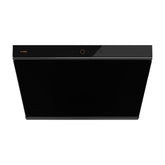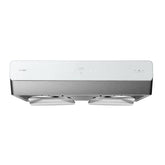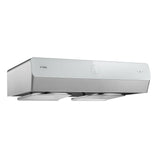How to Use an Electric Stove: Complete Beginner’s Guide
Last Updated: 4/30/2025
Author: James Zhao, Sr. Tech Specialist & Alex Park, Product Specialist
Electric stoves are sleek, easy to clean, and energy-efficient—but if you're used to gas, learning how to use an electric stove can be an adjustment.
This guide provides everything you need to start cooking with confidence. We’ll discuss the different types of electric stoves, how to prep them properly, smart cooking tips, and more so you can make mealtimes more enjoyable. Whether you're boiling pasta, sautéing veggies, or searing a perfect steak, we’ll help you do it better.
If you’re ready to upgrade your kitchen, FOTILE’s innovative electric ranges cut down on cleanup time, reduce cooking fumes, and help you create a safer, more enjoyable kitchen. Browse our full collection of electric ranges– cook smarter with FOTILE.
Understanding Your Electric Stove
Before turning on your cooktop, take time to understand how your electric stove works. Knowing the key features, settings, and components will help you cook more efficiently and safely.
Types of Electric Stoves
Not all electric stoves work the same way. Each type delivers heat differently:
- Coil Burner Electric Stove: Features visible metal coils that heat up and transfer heat directly to your pans. Affordable and durable, but not as easy to clean.
- Smooth-Top (Radiant) Stove: A sleek glass-ceramic surface with radiant heating elements underneath. It’s modern, simple to wipe clean, and fits seamlessly in most kitchens.
- Induction Stove: Uses electromagnetic energy to heat pots and pans directly. It’s the fastest, safest, and most energy-efficient—but it only works with magnetic cookware like stainless steel or cast iron.
Key Components of an Electric Stove
Understanding the parts of your stove can help you use it more effectively:
- Heating Elements: Visible coils or hidden radiant heat elements under glass that produce heat.
- Control Knobs or Digital Panel: Used to set temperatures and timers.
- Hot Surface Indicator Light: Alerts you when the cooktop surface is still hot.
- Burners: Circular cooking zones where your pots and pans sit.
- Oven Cavity (for range models): Great for baking, roasting, or broiling.
Electric Stove Settings & What They Mean
Understanding the temperature settings on your electric stove helps you avoid guesswork and get more consistent cooking results:
- Low: For simmering, melting, or warming delicate foods.
- Medium-Low: Gentle cooking—ideal for soft vegetables and eggs.
- Medium: A go-to for sautéing and everyday meals.
- Medium-High: Excellent for searing meat or boiling water quickly.
- High: Best for high heat stir-frying or bringing large pots to a boil.
- Warm/Keep Warm: Maintains heat without overcooking.
- Timer Functions: Many models allow you to set cook times to automatically turn off burners or the oven.
Electric Stove Safety Features
Modern electric stoves come with built-in safety features to prevent accidents and give you peace of mind in the kitchen:
- Hot Surface Indicator Lights: Stay on until the cooktop is safe to touch.
- Auto Shut-Off: Turns off the burner after a set time or if left unattended.
- Child Lock: Prevents kids from accidentally turning on burners or changing settings.
- Cool-Touch Controls: Control panels that stay cool even when the stove is hot.
- Residual Heat Sensors: Detect lingering heat and keep warning lights on accordingly.
How to Prepare Electric Stove For Cooking
Getting your electric stove ready before you start cooking makes the process smoother and safer. Here are a few simple steps to set yourself up for success:
- Check your power supply: Make sure your stove is plugged in properly, and your home's electrical system can handle the load.
- Clean the surface: Wipe down the stovetop to remove dust, crumbs, or spills that could burn or smoke.
- Choose the right cookware: Use flat-bottomed pots and pans that sit evenly on the burner—this ensures even heat distribution.
- Position your cookware: Center your pan on the burner for balanced heating and better results.
- Preheat if needed: Turn on the burner a few minutes before cooking so it’s ready when you are.
- Keep tools close: Have your utensils, ingredients, and oven mitts nearby to avoid leaving the stove unattended.
- Double-check controls: Make sure all knobs are turned off before you begin, then set your heat level.
Cooking Techniques on an Electric Stove
Electric stoves heat differently than gas, so it helps to adjust your approach for better control and consistency. These techniques will help you get the most out of your electric stove:
- Always Preheat: Electric coils and glass tops need time to warm up.
- Use the Two-Burner Strategy: Transfer hot pans to a cooler burner to avoid overcooking.
- Cook in Smaller Batches: Prevent overcrowding and keep heat consistent, especially when stir-frying.
- Slide, Don’t Lift: If food cooks too fast, slide the pan off the burner momentarily—heat lingers longer than with gas.
- Simmering Takes Patience: Use thick-bottomed pans to maintain a steady simmer.
- Adjust Heat Gradually: Electric stoves take time to respond to changes in settings.
- Use Lids When Cooking: Trap heat and moisture to cook faster and more evenly.
Electric vs. Induction Cooking
Electric and induction stoves may look similar, but they work in completely different ways. Here’s how each one operates—and how it can impact your cooking experience:
- Electric Cooking: Traditional electric stoves use heated coils or a glass surface to transfer heat to your cookware. The burner heats up gradually, and the pan gets hot from direct contact with that surface. It's reliable, easy to use, and compatible with a wide range of cookware.
- Induction Cooking: Induction stoves use electromagnetic energy to heat the pan directly—no hot burner involved. They’re faster, more precise, and safer since the surface stays relatively cool. However, they only work with magnetic cookware like stainless steel or cast iron.
Common Mistakes to Avoid When Using an Electric Stove
Even the most straightforward appliances come with a learning curve– avoid these common mistakes to cook more effectively with your electric stove:
- Turning up heat too quickly can scorch food before the pan is fully hot.
- Using warped or rounded cookware disrupts contact with the burner.
- Skipping preheating slows down cooking time and results.
- Leaving a hot stove unattended increases the chance of accidents.
- Ignoring warning lights can lead to burns.
- Not accounting for residual heat can overcook meals after the burner is off.
- Overcrowding your pan reduces heat and steams the food rather than searing it.
- Failing to clean regularly can cause odors and impact burner performance.
Beginner-Friendly Recipes to Practice
The best way to get comfortable with your electric stove is to start cooking. These simple, stovetop-friendly recipes will help you build confidence and get familiar with heat control:
- One-Pot Pasta: Simmer pasta, sauce, and add-ins like spinach or mushrooms in a single pan for an easy, no-fuss dinner.
- Pan-Seared Chicken Breast: Sear chicken over medium-high heat, then lower the temperature to finish cooking evenly.
- Veggie Stir-Fry: Preheat your pan, cook small batches of veggies over high heat, and finish with soy sauce or your favorite stir-fry sauce.
Electric Stove Cleaning and Maintenance
Cleaning your stove can help it work better and last longer. These easy tips will keep your stove running safely and efficiently:
- Wipe After Each Use: Prevent buildup before it becomes stubborn.
- Avoid Abrasives: Especially important for glass tops—use gentle cloths and cleaners.
- Clean Drip Pans: Remove and wash regularly to avoid odors.
- Be Careful With Water: Use minimal moisture around knobs and controls.
- Inspect Regularly: Replace worn coils or loose parts as needed.
- Don’t Use Your Stove as a Countertop: Avoid placing heavy items or cutting directly on the glass.
- Deep Clean Monthly: Remove grime, splatters, and burnt residue to keep your stove running efficiently.
Troubleshooting Common Issues
Electric stoves are dependable, but like any appliance, they can malfunction from time to time. Here are some common problems you may run into—and how to fix them quickly:
- Uneven cooking: Make sure your cookware has a flat bottom and is centered properly on the burner.
- Burners not heating properly: Check that the burner is fully plugged into its socket (for coil models) or test with a different burner to rule out damage.
- Stove not turning on: Confirm it’s plugged in securely, the circuit breaker hasn’t tripped, and the outlet is working.
- Burner stays too hot: Some heat retention is normal, but if it’s excessive, the internal thermostat may need repair.
- Indicator light won’t turn off: This usually means the burner is still warm—wait for it to cool, but if it persists, have the sensor checked.
- Strange smells or smoke: Clean off any grease or spilled food—residue can burn and release odors when the burner heats up.
- Digital controls not responding: Reset the stove by unplugging it for a few minutes, or consult the manual for a control panel reboot.
Upgrading Your Stove: When and Why
Even the most reliable electric stove won’t last forever. Here are some clear signs it may be time to upgrade to a newer, more efficient electric range:
- Uneven or inconsistent heating
- Burners take too long to heat up or don’t respond to temperature changes
- Frequent repairs or part replacements
- The surface is cracked, rusted, or permanently stained
- Your current model lacks modern safety features
Elevate Your Cooking Experience with a Fotile Electric Range
FOTILE’s electric ranges combine modern design with powerful performance to make everyday cooking smoother, safer, and more enjoyable. With faster heat-up times, easy-to-clean surfaces, and reduced cooking fumes, our ranges revolutionize your kitchen.
Learn how FOTILE can transform the way you cook—browse our collection of electric ranges today.
- Choosing a selection results in a full page refresh.






